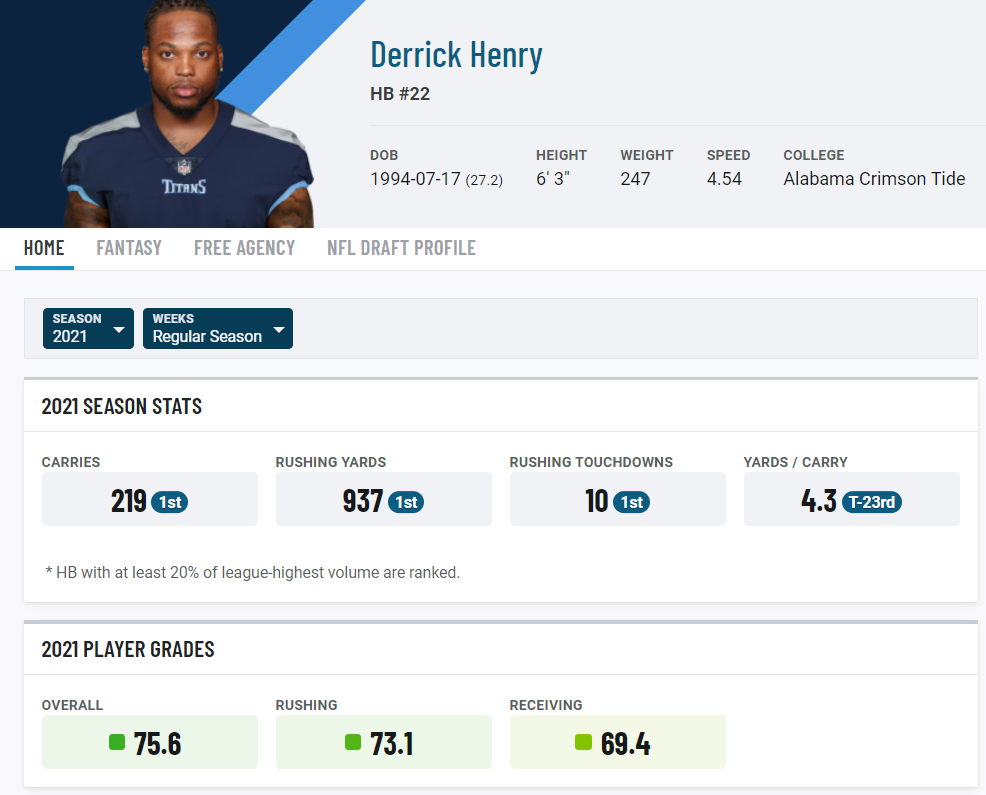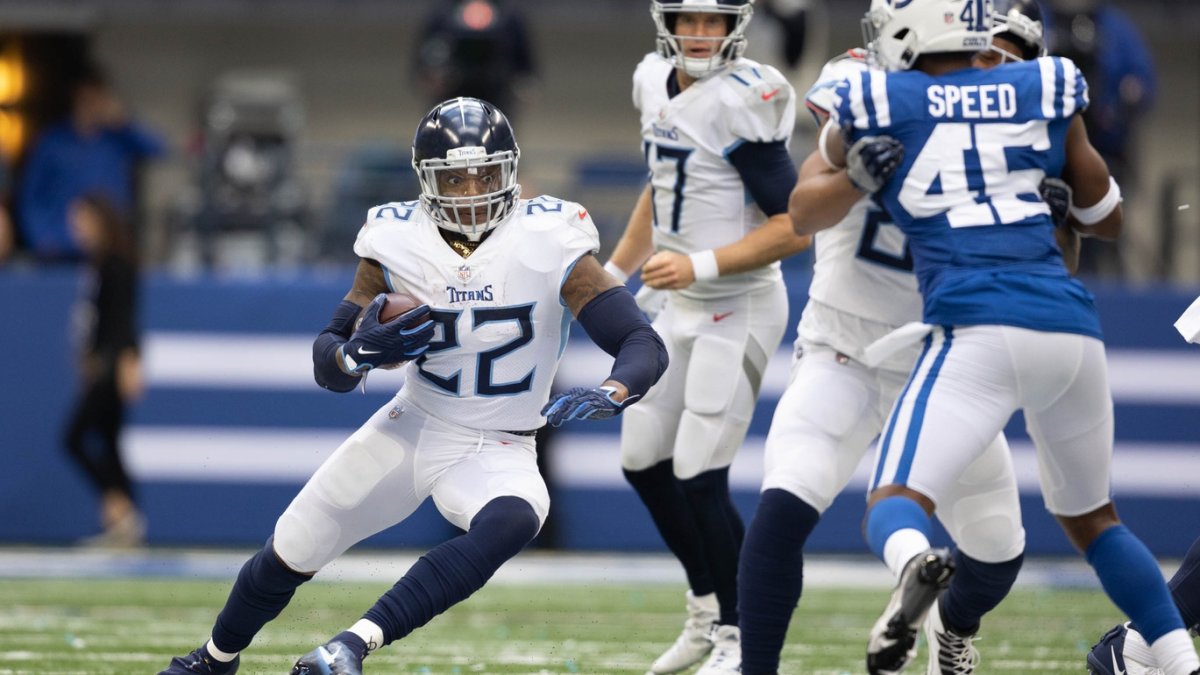The concept of the workhorse back has been left behind everywhere in the NFL, except for the Music City.
What the Tennessee Titans have had in Derrick Henry is a running back prototypically built to carry the physical load to drive the Titans' offense to greatness, especially since quarterback Ryan Tannehill entered the fold as his running mate. Since 2019, Tennessee’s offense has generated 0.171 expected points added (EPA) per play number when Henry has been on the field, a number that would rank behind only the Kansas City Chiefs.
Click here for more PFF tools:
Rankings & Projections | WR/CB Matchup Chart | NFL & NCAA Betting Dashboards | NFL Player Props tool | NFL & NCAA Power Rankings
But with Henry now sidelined likely until the start of the 2022 season due to a foot injury, the Titans will have to reimagine the way it's typically preferred to move the football. The team picked up veteran Adrian Peterson in the immediate aftermath, but that moves the needle little to none. Henry was on pace for over 400 carries prior to his injury, a number that would have outpaced seven teams in 2020. There’s no replicating (or intimating, for that matter) a strategy so reliant on a non-quarterback.
I couldn’t guarantee what this offense actually does with its play calling moving forward without No. 22 as a backbone. What we can do, with certainty, is look at the Tannehill/Henry era of the Titans' offense to see what kind of tendencies exist when anybody else is the running back for Tennessee.
Titans' Running backs | 2019-Present
| Player | % of Snaps on Early Downs | Early-Down Success % | % of Snaps on Conversion Downs | Conversion-Down Success % |
| Derrick Henry | 94% | 37% | 6% | 75% |
| Dion Lewis/ Jeremy McNichols | 50% | 37% | 50% | 34% |
The elements of situational football color the differences found throughout the data across the past two and a half seasons for Tennessee.
Looking first at the usage rate based on downs, the split in snaps for Henry is proof that the running back is not just a personnel package, but an offense on its own. No offense that uses one running back exclusively on first and second down is running the same offense with anyone else in the backfield.

The success rate data is revealing in situational usage, as well. There’s a wide disparity in how effective the offense is when Henry is on the field on third and fourth down when compared to current and former Titans Jeremy McNichols and Dion Lewis, but that’s a matter of the distance to the line to gain. Since 2019, 77% of Henry’s 102 conversion-down snaps were on third-and-short (1-2 yards) or fourth down, and 62% of his backups’ reps were on third-and-six or longer.
In short, Henry (and the passes off his run fakes) made up the entire “on-schedule” offense for Tennessee, and the severe differences between his usage and his teammates’ doesn’t end based on down and distance.
Titans' Running Backs | Since 2019
| Player | % of Snaps in 1st and 3rd Quarters | % of Snaps in 2nd and 4th Quarters |
| Derrick Henry | 51% | 47% |
| Dion Lewis/Jeremy McNichols | 31% | 67% |
The time on the clock has had a major influence on when Henry’s backups have been needed on the field. This contextualizes the 50-50 usage split between early downs and conversion downs for Lewis and McNichols, who pretty clearly have seen the field only late in the series or the half.
Continuing to tug on this thread predictably reveals changes in the kind of personnel packages used around these backs. For the backups, the Titans have sent them in as part of their spread offense, with 77% of the offense’s snaps happening with three wide receivers (11 personnel) on the field. That number is more than halved with Henry (37%), and it falls second to two-tight end sets (12 personnel), marginally leading all personnel groupings at 37.5%.
Titans' Running Backs | Since 2019 (with Ryan Tannehill)
| Player | Run/Pass % Split | Play Action Drop Back % | Rushing EPA/Play | Dropback Passing EPA/Play | Play-Action Pass EPA/Play |
| Derrick Henry | 58/42 | 57% | .055 | .114 | .370 |
| Dion Lewis/ Jeremy McNichols | 17/83 | 7% | -0.195 | .053 | .359 |
The last and most important piece is the way that play calling and play results are affected by Henry’s presence, or lack thereof, which has a direct influence on Tannehill, the rest of his teammates and the ways teams may defend this offense.
The data confirms our eye test and the box score: Tennessee isn’t anywhere near the same kind of rushing offense without Henry. Even when eliminating two-minute situations and conversion downs, the EPA per play number improves only slightly to -0.165 on 78 attempts.
The Titans also nearly double their dropback passing EPA per play mark when Henry is on the field, but situational context may be more important here than in the run game. When eliminating the same situations, the EPA per play figure with Lewis, McNichols and Tannehill (a name triumvirate fitting of a law firm) skyrockets to .257. That number is due in large part to how effective Tannehill has been when dropping back in the red zone, with nine touchdowns on just 44 attempts.

The play-action passes are where I expect most of the eyeballs in analytics to go, and rightfully so with how the Titans like to play. With the expected points added marks being only marginally different based on who’s been in the backfield, I can only imagine how loud the dialogue will be about how much running the ball means for “setting up” play fakes later.
Finally, despite how different the offense plays based on who's been in the backfield, defenses have approached this offense the same. Since 2019, the opposition has played zone on 57% of the passing snaps with Henry and Tannehill on the field. In the same span, the Lewis/McNichols and Tannehill pairing have seen zone on 55% of passing snaps. In terms of safety shells, Tannehill and Henry see single-high 69% of the time, compared to 70% with the backup running backs.
There’s nothing the film tells me that the data hasn’t — the portrait is pretty clear. Tennessee has two offenses, depending on the running back. Not only has the team lost its anchor and engine, but also its short-yardage offense and the overwhelming effectiveness of 12 personnel. Teams haven’t defended Tennessee any differently yet, but without the threat of a controlling run game, that may change. McNichols has been asked only to play a specific role, and there’s no way to build an offense out of third-down and two-minute drill play calls.
I’ve long maintained that running backs matter, because everything in football does. For Tennessee, though, being this reliant on a running back and losing him is almost the same as losing a quarterback. This offense will have to find a brand new identity via Ryan Tannehill's arm because the unit we’ve known can’t exist without an actual 6-foot-3, 240-pound titan to shoulder the load.



 © 2025 PFF - all rights reserved.
© 2025 PFF - all rights reserved.